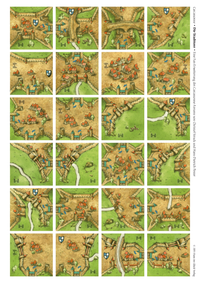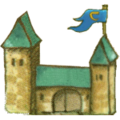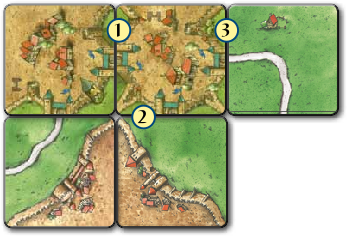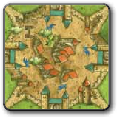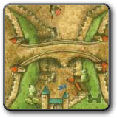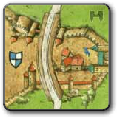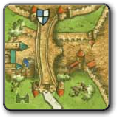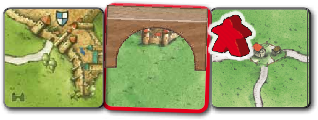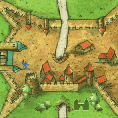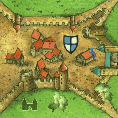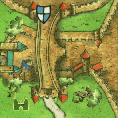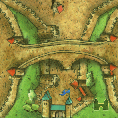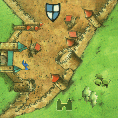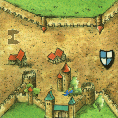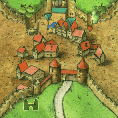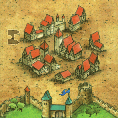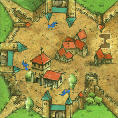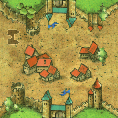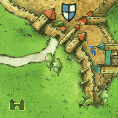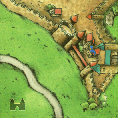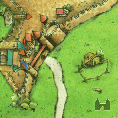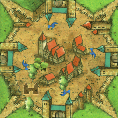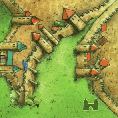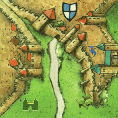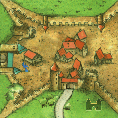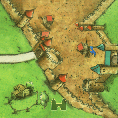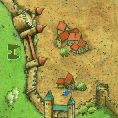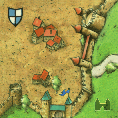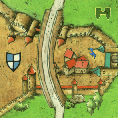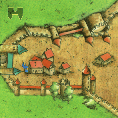Die Stadttore (Erste Edition)
 |
You are reading the rules for this tile design. |
| If your tiles have a different design, then choose a game from Spin-offs. |  |

The City Gates allow players to place a city gate on the edge of a tile to another city gate, but also to a road or to a field on the edge of tile, and vice versa. Players can easily complete their cities even if a tile with the desired configuration does not exist. And the shapes of the cities also allow the division of fields.
General info
Original Design von PresetM (CarcF).
Downloads
Please be aware that WikiCarpedia does not assume responsibility for the content of the links provided.
The expansions listed are governed by the regulations of their respective websites.
Commercial use of fan expansions is prohibited. These expansions are intended solely for personal use and may not be sold under any circumstances, including at cost price.
Contents
- 24 neue Karten
Regeln
Vorbereitung
Vor Spielbeginn werden die Karten unter die anderen Karten gemischt.
Spielablauf
1. Landschaftskarte legen
Die Landschaftskarten werden entsprechend den Grundregeln angelegt. Dabei sind folgende Besonderheiten zu beachten:
An die Seite eines Plättchens, an der sich ein Stadttor befindet, darf wahlweise eine Wiese oder eine Straße angelegt werden.
Ebenso ist es erlaubt ein anderes Stadttor anzulegen. In diesem Fall sind die 2 Stadtteile über die Stadttore nicht verbunden.
2. Gefolgsmann setzen
Für das Einsetzen eines Gefolgsmanns gelten die Regeln des Carcassonne- Grundspiels. Auf die Stadttore am Kartenrand werden keine Gefolgsmänner gesetzt. Auf die kleinen Wiesen neben den Stadttoren dürfen allerdings Gefolgsmänner als Bauern eingesetzt werden.
3. Punktewertung auslösen
Für die Wertungen während des Spiels gelten die Regeln des Carcassonne- Grundspiels. Für die Straßenwertung ist es wichtig zu wissen, dass eine Straße auch durch ein Stadttor begrenzt wird. Dies kann dazu führen, dass eine fertige Straße aus nur 1 Straßenabschnitt besteht.
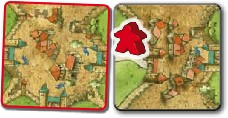 |
Links wird ein Stadttor an die Straße angelegt. Die Straße ist somit abgeschlossen und Rot bekommt 1 Punkt dafür. |
Legen der Karte einen Gefolgsmann in die
Stadt, erfolgt sofort eine Wertung, da die Stadt abgeschlossen ist. Der Spieler erhält 4 Punkte und nimmt seinen Gefolgsmann sofort in den Vorrat zurück.Final Scoring
Für die Schlusswertung gelten die Regeln des Carcassonne-Grundspiels.
Neue Karten
 |
Die Straße ist auf dieser Karte nicht unterbrochen. Am oberen Rand trennt sie die Wiese, am unteren Rand nicht. |
|
Auf diesen 2 Karten sind die Stadtteile unter den Brücken nicht unterbrochen. Unter der Brücke befindet sich also immer nur ein Stadtteil. |
Other expansions
Abtei & Bürgermeister: Die Abtei darf ebenfalls an ein Stadttor angelegt werden. Ebenso darf der Wagen beim Versetzen durch ein Stadttor fahren, es sei denn, am Stadttor liegt eine Wiese.
This section contains additional information about the interactions with other Carcassonne expansions.
Brücken, Burgen & Basare: Die Brücken aus dieser Erweiterung können ebenfalls in Verbindung mit den Stadttoren eingesetzt werden. Die Stadttore zählen dabei wie ein Straßenstück. Die nachfolgenden Anlegebeispiele illustrieren dies:
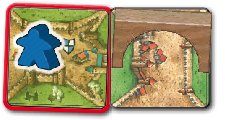
Rechts könnte an diese Brücke später z. B. eine Straße bzw. ein weiteres Stadttor angelegt oder auf einer Wiese erneut eine Brücke gebaut werden.
![]() The bridges from this extension can also be used in combination with the city gates. The city gates count like a piece of road. The following examples illustrate this:
The bridges from this extension can also be used in combination with the city gates. The city gates count like a piece of road. The following examples illustrate this:

To the right of this bridge, a road or another city gate could be built or a new bridge could be built on a farm.
}}
Schafe & Hügel: Der Schäfer darf ebenfalls auf die kleinen Wiesen neben den Stadttoren gesetzt werden.
![]() The shepherd may also be placed in the small farms next to the city gates.
The shepherd may also be placed in the small farms next to the city gates.
}}
New tiles
Tile distribution
Referenzen
Für Lizenzen und Erklärungen besuche Icons page.
- ↑
 This case is similar to closing a road end with an abbey tile when the builder is on the road (See
This case is similar to closing a road end with an abbey tile when the builder is on the road (See  Exp. 5 - Abbey & Mayor).
Exp. 5 - Abbey & Mayor).
